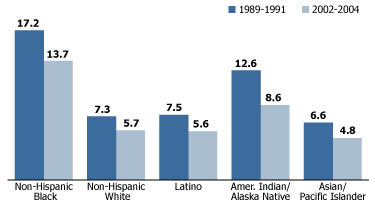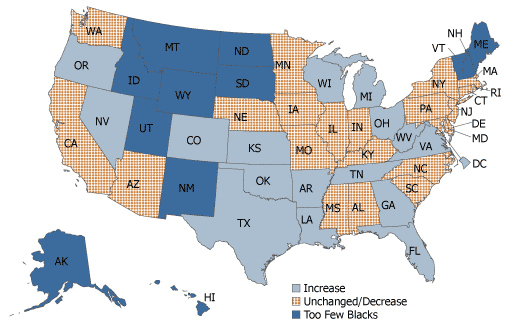Rogelio Saenz
Professor of Sociology, Texas A&M University

October 12, 2007
Professor of Sociology, Texas A&M University
How one fares in the United States has been characterized by a racial division that begins at birth with disparities in health care. Inadequate health care can have a significant effect on the future social and economic path of newborns.
Despite continued improvements in the health of the African American population, black babies are still nearly 2.5 times more likely than white babies to die before reaching their first birthday. To make matters worse, recent data show rising infant mortality among blacks in some states.
Infant mortality is associated with a variety of factors that include socioeconomic status, mother’s age, nutrition, birth weight, and lack of prenatal care. Recent increases in black infant mortality also coincide with significant cuts in programs designed to assist the poor and an erosion of benefits in jobs held by many poverty-level workers.
The trends in black infant mortality come at a time when, according to the National Center for Health Statistics, the overall rate “has not declined much since 2000, when it was 6.89.” The center reported this spring that the nation’s infant mortality rate in 2004 was 6.78 infant deaths per 1,000 live births, not significantly different from the 2003 rate of 6.84.
Blacks have consistently had higher infant mortality rates compared with other racial/ethnic groups in the United States.1 This gap continues. Blacks had the highest infant mortality rate during the 2002-2004 period (a three-year period yields greater statistical stability), when nearly 14 black infants died for every 1,000 births (Figure 1).
Figure 1
Infant Mortality Rates by Race and Ethnicity, 1989-1991 and 2002-2004

Note: The rates are three-year averages.
Source: National Center for Health Statistics, Health, United States 2006.
Furthermore, while the infant mortality rate went down for all racial/ethnic groups in the United States over the last 15 years, the 20 percent decline for blacks was somewhat slower than for other groups, ranging from a drop of 22 percent (whites) to 32 percent (American Indians/Alaska Natives). In the 1989-1991 and 2002-2004 periods, black babies were 2.4 times more likely than white babies to die in their first year of life.
High infant mortality rates are often associated with low socioeconomic status, but the relatively low rates for Latinos represent a paradox because Latinos tend to have lower educational attainment and income levels than non-Latinos. This lower Latino infant mortality has been attributed to factors including familial support, diet, and immigration selectivity, as well as methodological issues involving birth and death records.
During the 1990s, there were signs of improvements in the health of black infants in the 39 states with enough blacks for a reliable analysis (at least 20 black infant deaths during a given period). All of those states except Iowa and Oklahoma saw their black infant mortality rates decline between the 1989-1991 and 1998-2000 periods.
However, recent data show a partial reversal of this trend.2 Sixteen of the 39 states experienced rising black rates between the 1998-2000 and 2002-2004 periods (Figure 2). In 10 states, the rates rose by more than 5 percent, with the greatest increases registered in West Virginia, Kansas, Oregon, Tennessee, Texas, and Colorado.
Figure 2
Change in Infant Mortality Rate of of Blacks in U.S. States, 1998-2000 to 2002-2004

Source: National Center for Health Statisics, Health, United States, 2006.
These recent reversals helped widen the black-white infant mortality gap in many states. Indeed, this gap expanded in 25 states, or nearly two-thirds of the 39 states with sizeable black populations between the 1989-1991 and 2002-2004 periods. While these states are distributed across all regions, there is a noticeable cluster in the South.
Black babies’ odds of surviving their first year were particularly low in some states during the 2002-2004 period. Infant mortality rates were at least three times higher for black than for white newborns in four states: Colorado, Hawaii, New Jersey, and Wisconsin. In the District of Columbia, the rate was four times higher for black infants.
It is difficult to disentangle the direct links between the recent trends in infant mortality and their causes without additional research, but the persistence of this black-white gap challenges efforts to reduce health disparities. It is important to investigate factors behind this worrisome trend. Are more black women having high-risk pregnancies in some states than others? Have increases in unemployment or poverty rates reduced access to health care? Are fewer jobs providing health insurance? Did welfare cuts leave a greater share of black than white women without adequate health care?
The federal government’s Healthy People 2010 Initiative, a national initiative that targets preventable threats to health, aims to reduce the deeply entrenched health disparities across racial/ethnic groups in this country. Eliminating racial and ethnic health disparities will require significant changes including lowering the barriers that prevent blacks and other minorities from accessing social and economic opportunities and good health care.3 Currently, the lack of access to health care among the poor—especially those of color—places infants from these groups at a considerable disadvantage in surviving their first year of life and robs society of their potential economic and social contributions.
Policymakers need to invest in building the human and economic capacity of an increasingly minority youth population that will become our future workers and consumers.4
The author acknowledges the helpful comments of D’Vera Cohn, Karen Manges Douglas, Dudley Poston, and Carlos Siordia on an earlier draft of this report; and also appreciates the assistance of Robert N. Anderson, T.J. Mathews, and Arialdi M. Miniño in the acquisition of infant mortality for the 2002-2004 period.
